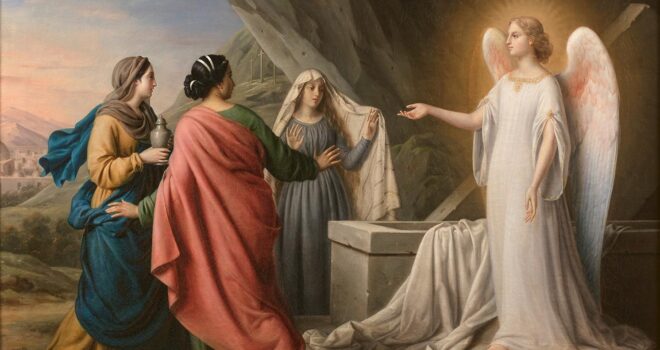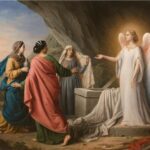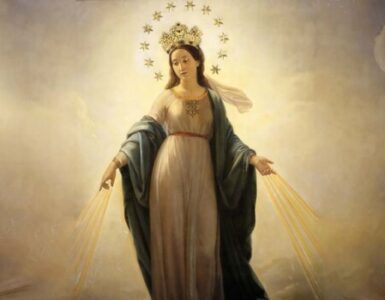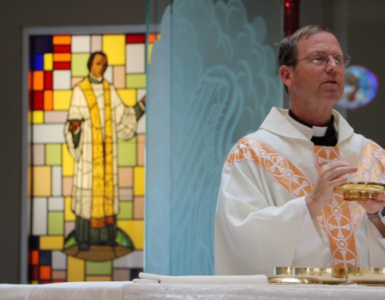Viewing and pondering sacred art, engaging in vizio divina, offers the faithful a great way to meditate more deeply on the life of Jesus Christ and the mystery of salvation. This series of articles will highlight several pieces of art related to the glorious Easter season, with specific attention to Scripture readings. Each of these pieces of art allows us to reflect on the astonishing realities of the resurrected life.
We have come through Lent and the Sacred Triduum to the holy season of Easter. We celebrate this triumph of Our Blessed Lord over death, first for a full octave (eight days) and then for six more weeks following! This is the longest season of our Church’s liturgical year, and rightfully so, because the faithful need more than one day, more than one week, to unpack the profound mystery that has shattered our conception of life.
The history of sacred art, especially during the last five centuries, is replete with images of Jesus rising from the tomb on Easter morning. Those familiar with art might quickly think of paintings by Francesca, Titian, Tintoretto, El Greco, Carl Bloch, or Peter Paul Rubens. While those great works of art offer perpetual opportunities for deeper meditation, it is also good to examine art that is a bit more peripheral. In 1843, a French female artist named Irma Martin provided her own visual interpretation of the Gospel authors’ accounts of Easter morning. Martin’s work provides viewers with an opportunity to ponder this episode from the perspective of the three women who had gone to the tomb to anoint Jesus’ body after the lawful sabbath rest (see Lk. 24:9-10 ESV).

A viewer quickly notices the setting of this scene. This tomb has a large opening, an opening that would have necessitated “a great stone” to cover it (Mt. 27:60). From the viewer’s vantage point, the artist connects the movements of Holy Week and the Paschal Triduum. At the very left-hand edge, the artist painted the holy city of Jerusalem, the site of Jesus’ last week of teachings, and the site of New Passover meal he had recently celebrated with his apostles. Between the city and the tomb, up a steep hill, stand three empty crosses. This hill is Golgotha, which is barely two hundred yards from the rock-hewn sepulcher. Have I come to appreciate the movements of Holy Week and the Paschal Triduum? Do I enter into those celebrations anticipating the glory of the Risen Lord?
Inside the tomb, viewers are greeted by the angel whose “appearance was like lightning, and his clothing white as snow” (Mt. 28:3). The angel extends his hand to the women, in a position that seems ready to gesture toward the tomb. As he does this, the angel speaks the message he was sent to convey from God: “Do not be afraid, for I know that you seek Jesus who was crucified. He is not here, for he has risen, as he said. Come, see the place where he lay” (Mt. 28:5-6). Has a message of truth, even something I might not have expected, come to me from the Lord and any of his messengers? Have there been times that such a message has been both shocking and beautiful, perhaps at the same time?
The angel gestures toward the empty sarcophagus at the center of the scene. Its lid is shoved to the side at an angle, showing that it has been quickly dislodged. An empty burial cloth crawls over the side of the sarcophagus, falling to the floor. Do I recognize the mysterious reality that the Resurrection is? Have I spent time letting the reality of the empty tomb sink in to my mind and heart? Have I tried to view all the mysteries of my own life in light of Jesus’ crucifixion and his Resurrection, which are both shocking and beautiful?
Just between the sarcophagus and the opening of the tomb are the three women who are the subjects of the painting. St. Mark tells us that these three women are “Mary Magdalene, Mary the mother of James, and Salome.” Although we do not know exactly which woman each figure is, each of these women are in a posture that is valuable for meditation.
The woman at the left of the scene holds a jar. This certainly is meant to depict the “spices, so that they might go and anoint him” (Mk. 16:1). Perhaps the spice that she holds is myrrh, which was commonly used in the ancient world to anoint bodies for burial. While it certainly is not specified in the scriptural texts, it would have rich meaning if this were the jar of myrrh that was presented by the Magi at Jesus’ Nativity, some three decades earlier. What do I bring to anoint Jesus as Savior and Lord?
Another woman is turned toward the viewer. Her gaze is fixed on the empty bomb, and she raises her right hand, like a student prepared to ask a question. The look on her face gives powerful expression to St. Luke’s comment about the thought these women had in this moment: “And they remembered his words…” (Lk. 24:8). Have I taken time to read and reflect on the words of Sacred Scripture, especially the Gospels, and realize how these are fulfilled in the Resurrection? Can I take time to do that (for the first time or again) during the Easter season, reading everything in the light of the Risen Lord?
The third woman has her back turned toward the viewer, and makes visible the group’s response to the instructions of the angel (see Mt. 28:7 and Mk. 16:7). This woman seems as though she is already moving away from the tomb and heading back to Jerusalem. She flings her arms open wide, as if to say “Enough! I can’t figure this out, but I know what I’ve been told to do.” Her position allows the viewer to ponder the whole group’s response as recorded in the Gospels: fear, trembling, astonishment and great joy (see Mt. 28:8 and Mk. 16:8). These details might cause any one of us to question: Do I have the disposition of going quickly to tell others about mysterious and miraculous realities? Do I respond in faith to God’s directions, even when I don’t quite understand fully?
Finally, in the bottom-right-hand corner, on the floor, lies a piece of red cloth with a lantern on top of it. This could be the author’s way of presenting the detail given by St. Matthew: “And behold, there was a great earthquake…. And for fear of him the guards trembled and became like dead men” (Mt. 28:2-4). The Roman soldiers who were guarding the tomb (see Mt. 27:62-66) were overcome by the sheer power of the Resurrection. Like these soldiers, have I been overcome, even shocked, by the reality and power of God? Am I willing to have my perspective changed, like the centurion who witnessed the crucifixion and then exclaimed, “Truly this was the son of God!” (Mt. 27:54)?
Martin’s painting faithfully and cleverly captures the details that we read in the Gospel accounts. It allows us to see the events of Easter morning from a different perspective than it is commonly presented. By gazing on this piece of art, we have an opportunity to meditate on the mystery and power of the Resurrection. Here’s hoping that our meditation, our silence listening for the Lord’s truth, impels us quickly on a mission to tell of his glory, just like these women on Easter morning.














